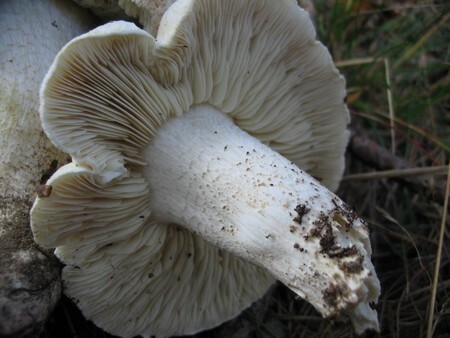gąska krokodylowa [caligatum] ma skórkowaty pierścień na trzonie, a poniżej niego czerwonobrązowe paski lub łuski , a u twojej tego nie dostrzegam.[chyba że Ty dostrzegasz?] zapach ma słodkawoowocowy, podobny do zapachu kwiatów gruszy lub głogu[za E.Gerhardtem].Ogólnie rzecz biorąc wydaje się faktycznie podobny.
jest to kultowy grzyb w Japonii jako Matsu-take :
http://cc.oulu.fi/~ehohtola/Anja_matsutake.jpg http://classes.plantpath.wsu.edu/plp521/Matsutake%203.JPG za wikipedią :
"...Matsutake (松茸, Tricholoma matsutake = syn. T. nauseosum) is the common name for a group of mushrooms in Japan, considered by the Japanese as the "king of autumn flavors". It has been an important element of Japanese cuisine for at least 1,000 years. The tradition of mushroom giving persists today in Japan's corporate world, and a gift of matsutake is considered special and is cherished by those who receive it.
Matsutake are hard to harvest and therefore the price is very high. Domestic productions of Matsutake in Japan have been sharply reduced over the last fifty years due to a pine nematode, and it has influenced the price a great deal. The annual harvest of Matsutake in Japan is now less than 1000 tons, and it is partly made up by imports from China, Korea, and Canada. The price for Matsutake in the Japanese market is highly dependent on quality, availability and origin. The Japanese Matsutake at the beginning of the season, which is the highest grade, can go up to $2000 per kilogram. In contrast, the average value for imported Matsutake is about $90 per kilogram.
The main recipes for matsutake are matsutake soup, matsutake rice, grilled matsutake, etc. Their magnificently spicy aroma, similar to cinnamon, enhances wild mushroom dishes and makes great recipes. The aroma lasts even after it is cooked. It is high in protein, low in fat and rich in vitamins B1, B2, and D, and is believed to have many beneficial health properties..."










